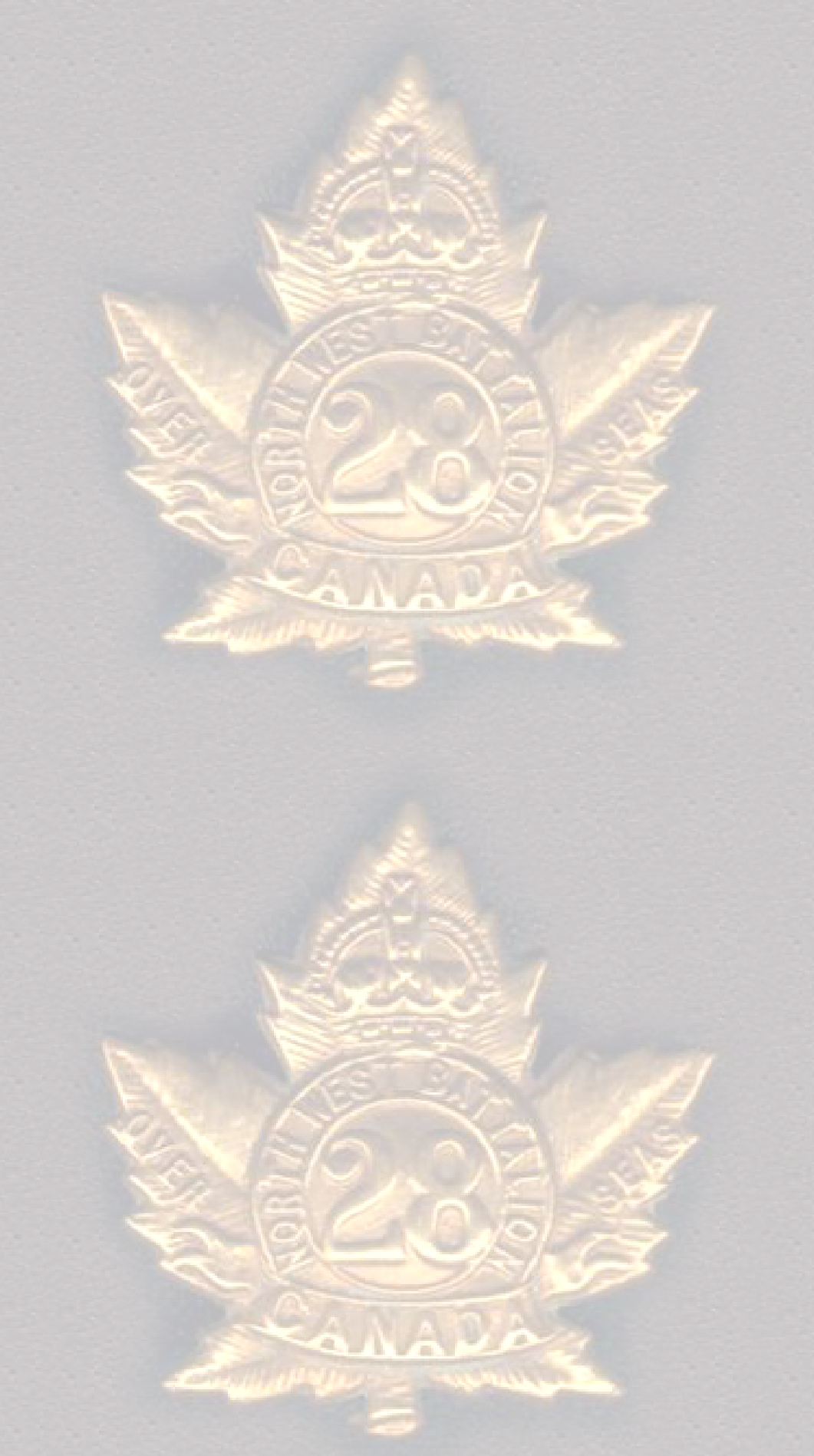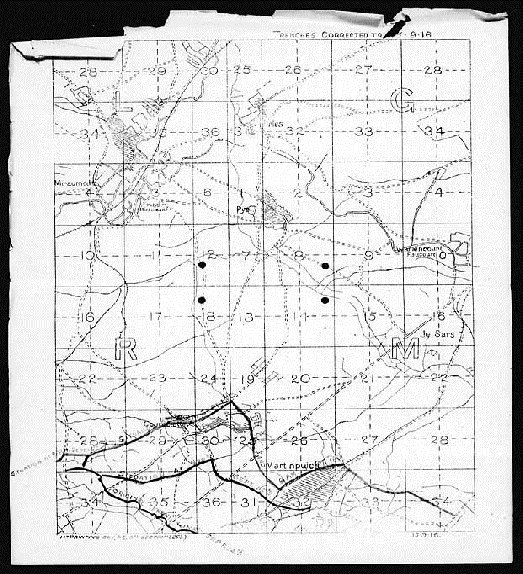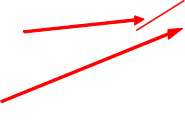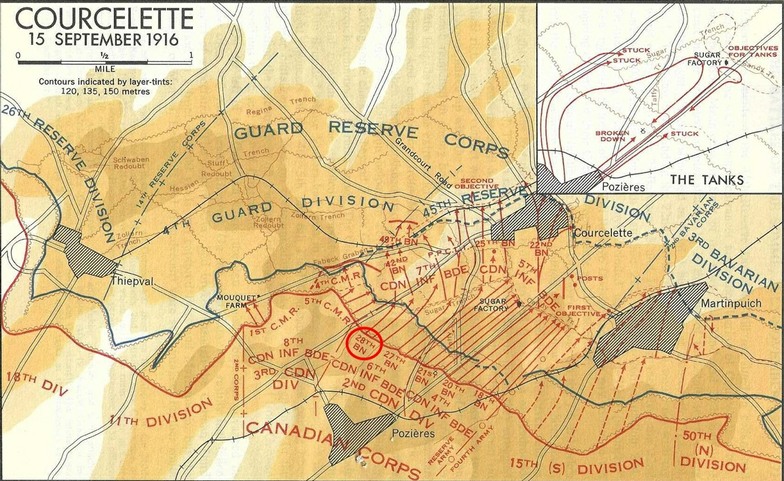
The War Diary of Lieutenant William L Hayes M C
1915—1919
1916 and the Somme
Battle of Courcelette 15 -
The Battle of Courcelette was the third and final battle of the Somme offensive. The objective was to break through a section of the German line and provide an opportunity for others to exploit. The objective was not achieved but the front line was advanced 2500 yards. The site is east of the July Somme battle lines, at Thiepval. It was the first time that tanks had been used in battle. It was also when the ‘creeping artillery barrage’ was first used to effect.
The battle area extended for ten miles from Combles, on the French left, to Thiepval. Objectives of the 2nd Division, making the main effort astride the Albert-


h
Enemy front line at 8 am
approx. position of 28th Bn at 1.15 pm 15 Sept. R34.b.9.71/2 along SUNKEN ROAD to R.29.c.8.3
Division situation at noon
Original front line 15 Sept
Map from 2nd Div War Diary, Sept 1916, page 420




From the War Diaries: (6th IB) 15 Sept. 6th Infantry Brigade carried out attack at COURCELETTE, 27th and 28th Bns assaulting. (WD28th Bn) 28th moved from BRICKFIELDS to point near CHALK PIT, bombs, sandbags, extra ammunitions, flares, picks, shovels drawn for men to carry. Hot meal taken up to men, interrupted by shell fire.
First wave from 28th consisted of 2 platoons from A,D & C Coys (rt to left) in jumping off trench. 3rd wave, 1 platoon from each, 4th wave 1 platoon from each all ready in assembly trench behind front line trench.
Communications difficult, mainly by runners
Tanks observed moving toward German trenches.
Zero hour 6.20 am, barrage began
7.37 28th Bn final objective reached., according to scout. But lost contact with 27th Bn
8.12 am message received that final objective of 28th achieved.
11 am report shortage of shovels and needed more Lewis guns
1.15 line was now R34.b.9.71/2 along SUNKEN ROAD to R.29.c.8.3
2.20 pm casualties estimated at 150
9.30 ordered to consolidate position
6.15 companies ordered out clearing wounded as they went.
8.45 am arrived at CHALK PIT the BRICKFIELDS Estimated Bn casualties 300 OR, 3 officers, 1 missing, 6 wounded
Company Quartermaster Sergeant (CQMS) assisted the Quartermaster and was a member of the Company HQ.
Duties of CQMS…. Stayed with company, responsible for rations, ammunition, but would still have been a front line soldier. http://www.1914-
'He is responsible for ALL the supplies that come into the Company. Uniforms, boots, ammunition, weapons, blankets, water, food (in some circumstances food is handled by the Warrant Officer Caterer). He has a small staff. It is his responsibility to ensure that all of the equipment that the Company needs is in store and in good order. It is a job of high responsibility.He answers to the Regimental Quarter Master (RQ) (usually a Major) and the Regimental Quartermaster Sergeant (RQMS) (usually a Warrant Officer Class 1, sometimes Class 2) as well as his own Company Commander (usually a Major) and the Adjutant (usually a Captain).
It is not normally his job to go out at night on ammunition delivery runs but in the situations that war throws up many people have to do things that are not specifically in their job description. The rule is "get the job done". If the boys up front need ammo bloody well get some up there. Don't ask who's job is this? get it there.
WLH/D Coy In the trenches
14—16 Sept
24—30 Sept
ESTAMINETS See 6th IB order no 1541, item 66, Aug 6th IB WD -
Given that soldiers spent most of their time behind the lines, cleaning equipment, digging trenches, training, bathing and resting, life was generally boring. Originally a small French Café, estaminets became about the only place where men behind the lines could get alcohol, a sing-
http://www.firstworldwar.com/battles/flers.htm
http://www.warmuseum.ca/firstworldwar/history/battles-
http://www.cobwfa.ca/pages/SOMME.htm https://carlpepin.files.wordpress.com/2010/08/courcelette2.jpg (Nicholson)
Meals may have been boring, but they were designed to provide men with over 4000 calories a day. Many men’s health improved during the war.